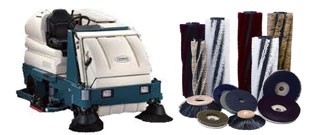|
 Sweeper Parts Newfoundland - Canada's easternmost province is Newfoundland and Labrador. It is situated within the Atlantic area of the country, including the mainland Labrador, situated northwest of the island of Newfoundland and the island itself. Together, these two land masses cover a combined area of 156,500 square miles or 405,212 square kilometers.
The estimated population of the province of Newfoundland and Labrador is nearly five hundred ten thousand residents, based on new statistics. Almost all of the provinces residents, practically 94% live on the main island and the smaller islands within the area. More than half of the population lives on the Avalon Peninsula. There are particular dialects on the island of Irish, English and French. In Labrador, the English dialect is similar to that of Newfoundland. On the mainland Labrador there are likewise languages of Inuktitut and Innu-aimun.
The city of St. John's is the largest city and also the capital of Newfoundland and Labrador. The city of St. John's is the 20th largest Census Metropolitan Area within the country. This city is home to roughly 40 percent of the province's population. It is home to the House of Assembly of Newfoundland and Labrador. In addition to being the seat of government, the city of St. John's is also home to the Newfoundland and Labrador Court of Appeal, that is the highest court in the jurisdiction.
Formerly a colony and dominion of the UK, Newfoundland and Labrador became the 10th province to enter the Canadian Confederation on the 31st of March, the year 1949, as Newfoundland. An amendment was made to the Constitution of Canada on the 6th of December, the year 2001, to officially change the name to Newfoundland and Labrador. Usually, in every day conversation, Canadians still refer to the province itself as Newfoundland. They normally refer to the region located on the Canadian mainland as Labrador.
The origin of the name Newfoundland is derived from English as "New Found Land" and is a translation from the Latin Terra Nova. It is unsure where the origin of Labrador originates from; it has been credited to a Portuguese explorer Joćo Fernandes Lavrador.
For lots of years the province of Newfoundland and Labrador has undergone some depression in the economy as Newfoundland and Labrador saw massive unemployment after the collapse of the cod fishery. During this time the population decreased by approximately sixty thousand. In recent years, the economy of the province has rebounded because of significant mining and oil discoveries offshore. The population has become stable, unemployment rates have decreased and there has been some moderate development in the area. The province of Newfoundland and Labrador have become ridden of their "have not" status because of recorded record surpluses.
The service industries like public administrations, financial services and health care take up the biggest share of the province's GDP. Other important industries consist of oil production, mining and manufacturing. In the year 2010, the total workforce of the province of Newfoundland and Labrador was recorded at 263,800 individuals. During 2008, the GDP per capita was 61,763 which was 3rd only to the provnces of Alberta and Saskatchewan amongst the provinces of Canadathe nation and was higher than the national average.
The fishing trade still to this day is a very important sector of the economy, with approximately four hundred forty million dollars in contributions to the GDP, while employing more than 26,000 people. The main fish harvested include haddock, cod, herring and mackerel, coming in at one hundred sixty five thousand tons during 2006, valued at roughly $130 million. That same year, shellfish including clams, crab and shrimp accounted for two hundred fifteen thousand tons at a value of $316 million. The seal hunt and its products accounted for $55 million.
| |
















